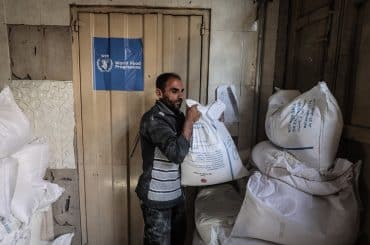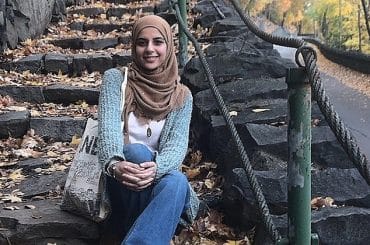Last Thursday I joined Palestinian, Israeli, and international activists for the “Open Shuhada Street” demonstration to demand Palestinian access to one of the most important streets in Hebron. Hebron, along with East Jerusalem, is unique in having settlers and Israeli soldiers occupy the very heart of a large Palestinian urban area.
The protest was held on February 25th to mark the 16th anniversary of the Ibrahimi Mosque massacre, when Israeli-American settler Baruch Goldstein shot and killed 29 Palestinians praying at the mosque and injured 150 more. Since the massacre, the IDF has instituted ever tightening restrictions on Palestinian movement throughout Hebron, and particularly on Shuhada Street where six settlement blocks were established. Today even Palestinian residents of Shuhada Street have to walk on complicated make-shift pathways on rooftops and climb over roadblocks to reach their home since walking or driving on the street is prohibited. (Read more on the “Open Shuhada Street” website.)
Organizers estimate 300 protesters attended. Demonstrators arrived in the Abu Sneineh district and were met by Israeli soldiers and jeeps blocking their entry into Shuhada Street. Although some Palestinian boys watching the demonstration from the street threw stones, all of the protesters remained steadfastly committed to non-violence while the IDF repeatedly threw tear gas canisters and percussion grenades into the crowd. At least five protesters, including PLC member Mustafa Barghouti, were hospitalized for tear gas inhalation.
Hisham Sherabati, one of the organizers of the march with the Hebron-based group Youth Against Settlements, told me that there were participants from nearly every Palestinian political party along with Palestinian-Israelis, Jewish-Israelis, and internationals from around the world. The event, he said, had become not only an act of non-violent resistance to the closure of Shuhada Street to Palestinians on the anniversary of the Ibrahimi mosque massacre, but also an expression of condemnation of the Netanyahu claim for the Cave of the Patriarchs/Ibrahimi Mosque as an Israeli national heritage site, and part of the larger movement. ”We are part of the Palestinian popular nonviolent resistance of the occupation,” Sherabati said. He explained the necessity for this day of action:
“It’s crucial to unite our efforts to address the issue of apartheid in Hebron, where there is a systematic separation between Palestinians and illegal Israeli settlers, where very important streets have been given to extremist settlers.”
Before the protest began, I caught up with PLC member and 2010 Nobel Peace Prize nominee Mustafa Barghouti. He noted that the protest was important to raise awareness about the nature of segregated roads in the Occupied Palestinian Territories:
“Roads are segregated in what has become one of the worst apartheid systems in the world. Even in South Africa under apartheid and in the United States under segregation, the roads were never segregated.”
In 1995 Israel and the PLO signed the Israeli-Palestinian Interim Agreement on the West Bank and Gaza Strip, more commonly known as the Oslo II Agreement. This agreement stipulates that “measures and procedures for normalizing life in the Old City and on the roads of Hebron will be taken immediately after the signing of this Agreement” (Annex I, Article VII).
In fact, this agreement required Israel to remove obstacles to Palestinian movement specifically on the very site where the IDF clashed with protesters on Thursday. By signing Oslo II, Israel agreed to implement “removal of the barrier on the road leading from Abu Sneineh to Shuhada Road in order to facilitate the movement on these roads”. (See full text of Oslo II at the Israeli government website here.)
Over 25 cities world-wide, from Capetown to Prague to New York City, held protests, vigils, and other events to mark February 25th as the kickoff for the “Open Shuhada Street” campaign. The campaign itself began as a joint Palestinian-International campaign in a meeting in Hebron of activists from Youth Against Settlements and activists from South Africa. Sherabati explained that the day of action was the beginning of building a global and sustainable movement to open Shuhada Street as an important part of ending the occupation.
“We are very sure that sooner or later the street will be open and will be given back its identity. We erase the name King David Street, like the settlers call it. And we erase the name Chicago Street – that’s what the military calls it. We’re giving it back the name ‘Shuhada Street’.”
Katya Reed is a freelance journalist based in Bethlehem, West Bank, Occupied Palestine.

